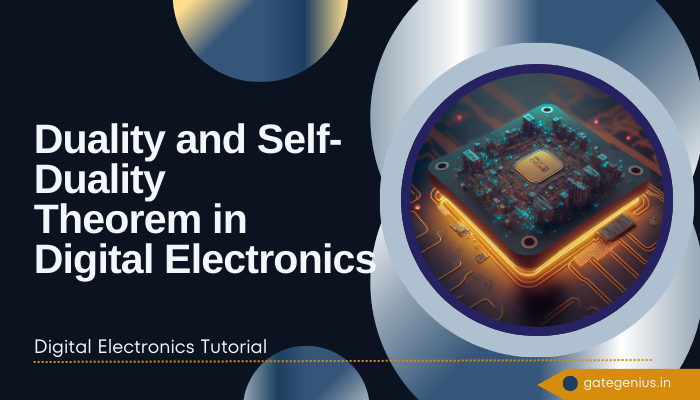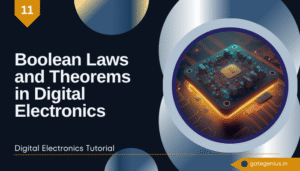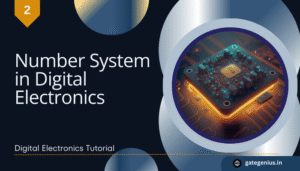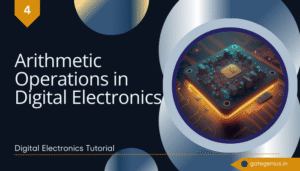In the foundational world of Boolean algebra and digital circuit design, certain principles act as powerful tools to simplify analysis and unlock efficiencies. Among these, the Duality Theorem stands out as a fundamental and elegant concept. Alongside it, the idea of Self-Duality presents a fascinating special case. Understanding these theorems is crucial for anyone preparing for GATE, UGC NET exams, or delving deeper into advanced digital electronics. This tutorial will demystify these concepts, explaining their principles, applications, and significance.
What is the Principle of Duality?
The Principle of Duality is a defining characteristic of Boolean algebra. It states that:
Every Boolean algebraic expression remains valid if the operators and identity elements are interchanged.
This means:
- The OR (
+) operator is replaced with the AND (·) operator. - The AND (
·) operator is replaced with the OR (+) operator. - The identity element 1 is replaced with 0.
- The identity element 0 is replaced with 1.
The dual of any Boolean expression is denoted with a superscript ‘d’.
Key Point: The variables themselves remain unchanged; only the operators and constants are swapped.
Examples of Finding the Dual
Let’s apply the duality principle to some common Boolean expressions.
- Expression:
X + 1 = 1- Dual:
X · 0 = 0(Interchanged+with·and1with0)
- Dual:
- Expression:
X · (Y + Z)- Dual:
X + (Y · Z)(Interchanged·with+and+with·)
- Dual:
- Expression:
A + B' · C- Dual:
A · (B' + C)(Note: The complementB'remains unchanged. Only operators are swapped).
- Dual:
The Duality Theorem
The Duality Theorem builds upon the principle and is a more powerful formal statement. It asserts that:
If a Boolean statement or expression is proven to be true, then its dual is also automatically true.
The theorem saves immense effort. You don’t need to prove both a statement and its dual separately. Proving one automatically validates the other.
Example of the Duality Theorem in Action:
- Statement 1 (Absorption Law):
A + A · B = A - Its Dual (also an Absorption Law):
A · (A + B) = A
Because the first statement A + A · B = A is true, its dual A · (A + B) = A must also be true. This is a classic application of the theorem.
What is a Self-Dual Function?
A Boolean function f is said to be self-dual if the function is equal to its own dual.
Definition: f(X1, X2, ..., Xn) = f^d(X1, X2, ..., Xn)
A crucial property of self-dual functions is that they neutralize the effect of complementation. For a function to be self-dual, it must satisfy the condition:f(A1, A2, ..., An) = f'(A1', A2', ..., An')
In other words, the output of the function for a given input must be the opposite of the output for the complement of that input.
Example of a Self-Dual Function:
The function f(A, B) = A · B' + A' · B (which is the XOR function) is self-dual.
- Let’s find its dual:
f^d(A, B) = (A + B') · (A' + B) - Using Boolean algebra, we can simplify
f^d:(A + B') · (A' + B) = A·A' + A·B + B'·A' + B'·B= 0 + A·B + A'·B' + 0= A·B + A'·B'(This is the XNOR function, which is the complement of XOR,f').
- This shows
f^d = f', which seems to contradict. However, the standard test for self-duality isf(A1, A2, ..., An) = f'(A1', A2', ..., An').- For input (0,0):
f(0,0) = 0. The complement of the input is (1,1).f'(1,1) = (1 XOR 1)' = (0)' = 1. This does not satisfy. - A correct self-dual example is a 1-variable function:
f(A) = A.- Its dual is
f^d(A) = A(replacing AND with OR and vice versa in a single variable changes nothing). - Therefore,
f(A) = f^d(A) = A. It is self-dual.
- Its dual is
- For input (0,0):
A more common and practical example is a self-dual logic gate, like the buffer. Its output strictly follows its input, making it self-dual.
Key Differences Between Duality and Self-Duality
| Feature | Duality Principle | Self-Duality |
|---|---|---|
| Definition | A principle where operators and identities are swapped. | A special property where a function is equal to its dual. |
| Result | Creates a new, related expression or theorem. | The function remains unchanged after applying duality. |
| Commonality | Applies to all Boolean expressions and theorems. | Applies only to a specific subset of Boolean functions. |
| Requirement | Only requires swapping +/· and 0/1. | Requires f(A1, A2, ...) = f'(A1', A2', ...) to be true. |
Applications and Importance
- Circuit Design: Understanding duality allows designers to easily convert between AND-OR (SOP) and OR-AND (POS) circuits, which can lead to more efficient implementations using only NAND or NOR gates.
- Theorem Proof: The Duality Theorem cuts the work of proving Boolean identities in half.
- Error Detection: The concept is used in designing self-checking circuits and fault-tolerant systems.
- Formal Verification: Crucial for proving the equivalence of different circuit representations.
Frequently Asked Questions (FAQs)
A. The principle is the method of swapping operators and identities to create a dual expression. The theorem is the statement that if an expression is true, its dual is also true.
A. No, the NAND gate is not self-dual. For example, the dual of the NAND function (A·B)' is (A+B)' (which is the NOR function). Since they are not the same, it is not self-dual.
A. Conventional algebra (real numbers) has different properties. For example, in Boolean algebra, X + 1 = 1, whose dual is X · 0 = 0. Both hold true. In conventional algebra, x + 0 = x is true, but its dual (if we try to apply the same swap) x * 1 = x is also true. However, x + y = z has a dual x * y = z, which is not universally true, showing the rules don’t form a consistent dual system like Boolean algebra.
A. De Morgan’s Laws are the most famous examples of dual relationships. The first law, (A + B)' = A' · B', is the exact dual of the second law, (A · B)' = A' + B'.
Conclusion
Mastering the Duality and Self-Duality Theorem provides a deeper, more intuitive understanding of Boolean algebra’s symmetrical nature. It’s not just a theoretical curiosity but a practical tool that simplifies proofing, optimizes design, and reveals the elegant structure underlying digital logic systems. For students and professionals alike, this knowledge is indispensable for advanced studies and efficient digital circuit design.
I hope you understood the concepts of Duality and Self-Duality Theorem in Digital Electronics. So don’t forget to share this post with friends and anyone preparing for the GATE, UGC NET exams, or studying at the university.



